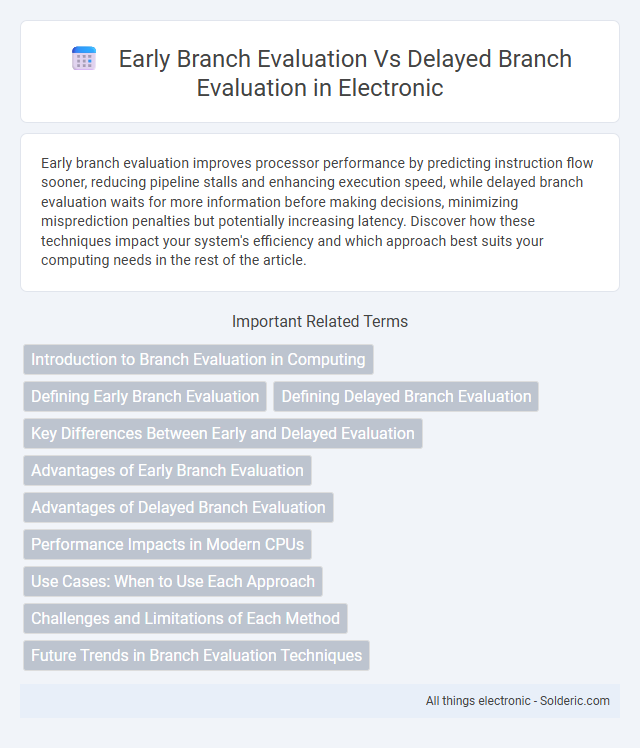Early branch evaluation improves processor performance by predicting instruction flow sooner, reducing pipeline stalls and enhancing execution speed, while delayed branch evaluation waits for more information before making decisions, minimizing misprediction penalties but potentially increasing latency. Discover how these techniques impact your system's efficiency and which approach best suits your computing needs in the rest of the article.
Comparison Table
| Feature | Early Branch Evaluation | Delayed Branch Evaluation |
|---|---|---|
| Definition | Branch decision made immediately after branch instruction | Branch decision postponed; next instruction(s) executed before branching |
| Branch Penalty | Higher, due to pipeline stalls on branch | Reduced, utilising delay slot(s) to keep pipeline filled |
| Pipeline Utilization | Lower, pipeline stalls frequently occur | Higher, delayed branch slots improve pipeline efficiency |
| Implementation Complexity | Simpler control logic | More complex due to managing delay slots and instruction ordering |
| Performance Impact | Possible performance degradation from branch hazards | Improved performance by minimizing pipeline bubbles |
| Example Architectures | x86, ARM (basic branch prediction) | MIPS, SPARC (delayed branch slots) |
Introduction to Branch Evaluation in Computing
Branch evaluation in computing determines the execution path based on conditional statements, impacting processor performance and control flow efficiency. Early branch evaluation resolves branch conditions immediately after they are computed, enabling faster pipeline decisions but risking pipeline stalls due to mispredictions. Delayed branch evaluation postpones the decision to a later pipeline stage, reducing stalls by allowing subsequent instructions to execute regardless of the branch outcome, often improving overall instruction throughput.
Defining Early Branch Evaluation
Early branch evaluation refers to the technique in processor architecture where the outcome of a branch instruction is determined as soon as possible in the pipeline to minimize stalls and improve instruction throughput. This approach contrasts with delayed branch evaluation, which postpones the branch decision to allow for smoother instruction flow but can introduce additional complexity in pipeline control. Understanding early branch evaluation enables you to optimize CPU performance by reducing the cost of mispredicted branches and enhancing overall execution efficiency.
Defining Delayed Branch Evaluation
Delayed branch evaluation is a technique in computer architecture where the instruction immediately following a branch is executed regardless of whether the branch is taken. This method improves pipeline efficiency by reducing the penalty caused by branch instructions disrupting instruction flow. You benefit from smoother execution and better CPU performance due to minimized branch stalls through delayed branch evaluation.
Key Differences Between Early and Delayed Evaluation
Early branch evaluation determines the target of a branch instruction immediately after the instruction is decoded, minimizing branch delay but increasing pipeline control complexity. Delayed branch evaluation postpones the decision to a later pipeline stage, allowing subsequent instructions to be fetched and executed regardless of the branch outcome, which reduces pipeline stalls but may introduce branch delay slots. The key difference lies in timing: early evaluation optimizes for minimal latency at the cost of pipeline complexity, whereas delayed evaluation trades off latency for simpler pipeline control and smoother instruction flow.
Advantages of Early Branch Evaluation
Early branch evaluation enhances processor performance by predicting branch outcomes sooner, minimizing pipeline stalls and improving instruction flow. This approach reduces latency and increases instruction-level parallelism, leading to faster execution and higher throughput. By addressing branches early, your system can maintain smoother workflows and optimize overall computing efficiency.
Advantages of Delayed Branch Evaluation
Delayed branch evaluation improves pipeline efficiency by minimizing stalls and branch penalties in CPU execution. By executing instructions in the delay slot regardless of whether the branch is taken, Your processor maintains smoother throughput and better resource utilization. This technique enhances overall performance by reducing the impact of control hazards on instruction flow.
Performance Impacts in Modern CPUs
Early branch evaluation enables CPUs to predict and resolve branches quickly, reducing pipeline stalls and improving instruction throughput. Delayed branch evaluation can mitigate the cost of mispredicted branches by postponing execution decisions, but may introduce latency in resolving control flow, impacting overall performance. Your processor's efficiency depends on balancing these techniques to optimize pipeline utilization and minimize branch misprediction penalties.
Use Cases: When to Use Each Approach
Early branch evaluation is ideal for high-performance computing systems where minimizing pipeline stalls and reducing branch misprediction penalties are critical, such as in real-time processing and gaming applications. Delayed branch evaluation suits architectures prioritizing simpler control logic and lower hardware complexity, making it effective in embedded systems and low-power devices where conserving resources is essential. Understanding your application's performance requirements and hardware constraints will guide your choice between these two branch evaluation strategies.
Challenges and Limitations of Each Method
Early branch evaluation faces challenges with pipeline hazards and increased branch misprediction penalties, limiting instruction-level parallelism and overall CPU efficiency. Delayed branch evaluation reduces pipeline stalls by postponing branch decisions but complicates compiler design and requires careful instruction scheduling to avoid executing unintended instructions. Your choice between these methods impacts processor performance trade-offs related to latency and control flow accuracy.
Future Trends in Branch Evaluation Techniques
Future trends in branch evaluation techniques focus on enhancing processor performance through more accurate prediction algorithms and hybrid models combining early and delayed branch evaluation for optimal instruction flow. Advances in machine learning and adaptive heuristics enable dynamic adjustment of branch prediction strategies based on runtime behavior, reducing misprediction penalties. Your system's efficiency can significantly improve by integrating these intelligent branch evaluation methods, which anticipate program paths with higher precision.
Early branch evaluation vs delayed branch evaluation Infographic

 solderic.com
solderic.com